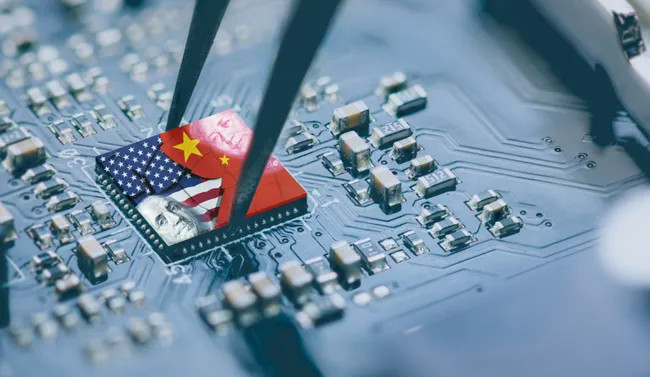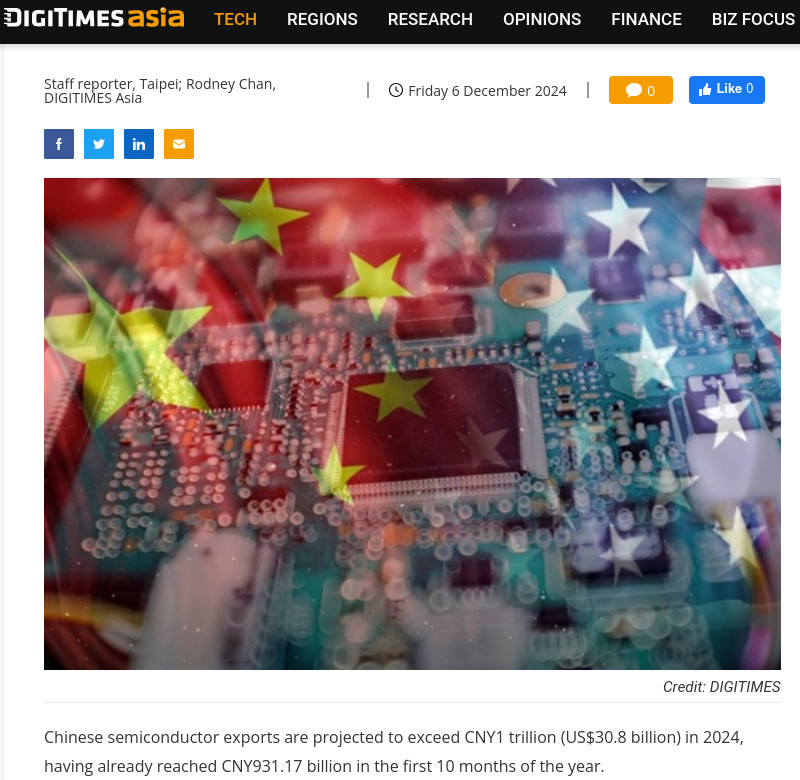Meanwhile Intel saw its revenue drop in China amid a record quarterly loss, 18,000 staff cut, and revenue drop in Q3 YoY. China account for 25-30% of Intel market. With the latest ban, Nvidia, Qualcomm can also expect to be impacted in coming years. Their hope pins on the explosive growth of the AI market, whether the growth in coming years will be explosive remain to be seen.
Meanwhile China export of semiconductor continue to grow. Revenue expected to exceed CNY 1 trillion (US$30.8 billion) this year. Stock of Chinese semiconductor sector also rise on the news of US ban.
Many Chinese fabs were built starting around 2021 and enter production around 2022-2023, initially with smaller scale production. Production pace start to pick up and normalize in 2024. Large scale fab investment continues amid expectation of growing US ban. More advanced fabs will enter production starting from 2025. TW has the most semiconductor fab, around 20, follow by S. Korea's 15 fabs. By the end of 2025, China will have close to 50 fabs, most of which are built in the past 3 years.
China market accounted for around half of world semiconductor import. China's semiconductor import dropped around 10% in 2023, 10-15% in 2024, and is expected to drop further in coming years, perhaps at 20% rate. Foreign semiconductor will be replaced by domestic semiconductor.
China declares US chips unsafe, urges companies to use domestic semiconductors
By Benedict Collins | published 4 December 2024
China has hit back with sanctions of its own

- China has shadow-banned US semiconductors
- The sanctions hit back against US export controls for chip manufacturing kit
- China has also restricted exports of rare minerals used in military devices
China has hit back against the latest round of US sanctions by declaring US semiconductors "no longer safe" for use by Chinese organizations.
The US recently issued its third round of sanctions to limit China’s ability to produce semiconductors domestically by restricting companies from selling chip assembly technology to the nation.
China did not offer any evidence or reasoning as to why US semiconductors were unsafe, but it is likely an attempt to steer Chinese markets away from using imported chips from companies such as Nvidia, AMD, and Intel and on to domestic productions.
Chip war continues
China’s warning isn’t a ban on US chips per se, but the Internet Society of China told companies to carefully consider their choice of semiconductor manufacturers, and urged organizations to use China’s growing domestic market of chips “proactively.”
Last year, China added several specific semiconductors produced by Intel, AMD, and other chip manufacturers to a blacklist, forcing companies to shift away from Western technology. Moreover, a group representing China’s cybersecurity professionals claimed that Intel was installing backdoors into CPUs to be used by the NSA for espionage.
Additionally, China has banned the export of gallium, antimony, and germanium to the US due to their use in both military and civilian applications. China accounts for 98% of the world's raw gallium production, 48% of antimony, and 83% of germanium, causing prices to skyrocket and likely forcing the US to seek alternative sources.
As part of the warning against the use of US semiconductors, the China Association of Communication Enterprises has urged Beijing to investigate potential supply chain vulnerabilities in critical infrastructure that use Western-produced semiconductors.
Related link: China declares US chips unsafe, urges companies to use domestic semiconductors
Intel's revenue drops amid trade curbs
By HENG WEILI in New York | chinadaily.com.cn | Updated: 2024-08-05 11:00
US chipmaker Intel, citing "geopolitical and trade tensions", saw its second-quarter business drop in China and overall while announcing a major workforce reduction to reduce operating expenses.
"Our Q2 2024 revenue was unfavorably impacted by the revocation of certain licenses for exports of consumer-related items to a customer in China," the company said in its 10-Q filing Thursday with the US Securities and Exchange Commission.
Among the business risks the company cited in the forward-looking statements section of the report were "macroeconomic conditions and geopolitical tensions and conflicts, including geopolitical and trade tensions between the US and China".
The Silicon Valley company, in Thursday's earnings release, said that it will lay off more than 15 percent of its workforce, which amounts to about 17,500 employees, by year-end and suspend its dividend. Intel's quarterly revenue was $12.8 billion, down 1 percent year-over-year.
Intel also has been picked to receive billions of dollars in federal government subsidies under the 2022 CHIPS and Science Act — which is aimed at competing with China.
The company has struggled to compete in artificial intelligence, while other US chipmakers Nvidia and AMD have done well. Intel's lagging position in the market for AI chips has contributed to its shares falling more than 40 percent this year, Reuters reported.
"Share loss and structural shift from traditional CPU-centric compute to AI-accelerated continues to weigh on Intel," wrote Oppenheimer analyst Rick Schafer, reported Barron's.
Intel, based in Santa Clara, California, is in the middle of a turnaround plan aimed at developing advanced AI processors and expanding its for-hire manufacturing as it looks to compete with Taiwan Semiconductor Manufacturing Co (TSCM), the largest contract chipmaker in the world.
"Our revenues have not grown as expected — and we've yet to fully benefit from powerful trends, like AI. Our costs are too high, our margins are too low," CEO Pat Gelsinger said in a memo to staff Thursday.
In July 2023, at the Aspen Security Forum, Gelsinger noted that China represents 25 percent to 30 percent of semiconductor exports.
"If I have 25 percent to 30 percent less market, I need to build less factories," Gelsinger said. "You can't walk away from 25 to 30 percent and the fastest-growing market in the world and expect that you (continue) funding the (R&D) and the manufacturing cycle that we've released."
CFO David Zinsner said on an earnings call Thursday that the chipmaker expects weaker consumer and enterprise spending in the current quarter, especially in China.
Intel shares closed at $21.48 on Friday in Nasdaq trading, down $7.57, or 26 percent.
..........
Related link:
Intel's revenue drops amid trade curbs
